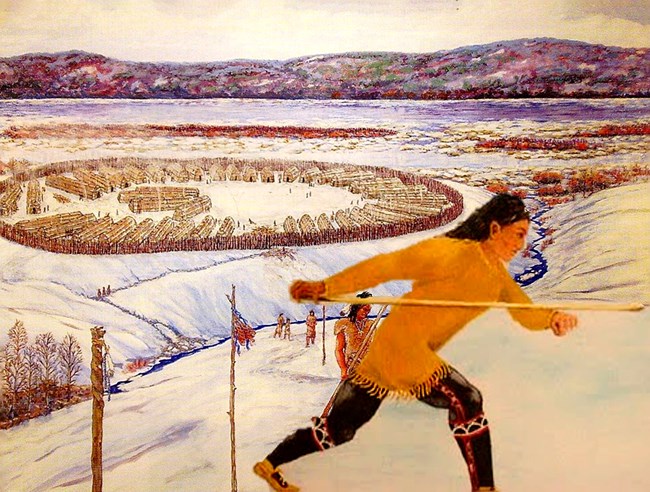What Animals Were Important To The Iroquois Tribe

Image Courtesy of Northward Museum/Blue Stone Heritage Center
How did Susquehannock people survive the winter in the Susquehanna River Valley? A sold-out crowd showed up last week at the Susquehanna National Heritage Area's Zimmerman Center for Heritage to find out. The Zimmerman Eye's Paul Nevin discussed how Native people not merely survived, but embraced the common cold season. Nevin is an dominance on the Susquehanna River's American Indian petroglyphs and has extensively studied the Susquehannock's history and culture.
The Susquehannock people, who were culturally related to the Iroquois of New York'southward Finger Lakes Region, moved to Pennsylvania's Susquehanna Valley around 1550 Advertising. One time a dominant power, disease brought virtually through contact with Europeans decimated their population past 1675. Today, there exists no descendant Susquehannock community.
Nevin theorized virtually Susquehannock life in the winter using bear witness provided through archaeology, and by studying what other Iroquoian people did during these common cold months.
Essential to anyone's survival in winter, Nevin said, is the ability to stay warm and find enough food. The Susquehannock people lived in big agricultural communities. Corn provided virtually half of their diet, and forth with beans and squash, had to be preserved for the winter. The Iroquois developed applied science to be successful at this. They stored dried crops in underground pits lined with dried grasses and barks, and could use sumac leaves as wrappings and natural preservatives for dried pieces of squash. Animals were hunted more than hands during winter considering vegetation died back, and drowsy or hibernating animals were easily plant and taken. Cold weather fabricated it easy to preserve their meat. Along with eating, people would not survive without the warmth of burn down. The Susquehannock would have known the best fire-making materials and techniques necessary to survival. They would also accept known the best ways to craft furs and establish material into warm apparel and bedding.
Winter was more than only a time of survival. It provided opportunities to be close and to socialize. The long nights afforded fourth dimension to pass along wisdom and lift spirits with storytelling. Games were played both inside and outside their longhouses. The Susquehannock may accept, like other Iroquoians, held a Mid-Winter Anniversary in which prayers, feasting, and healing rituals took place.
Nevin suggested that peradventure the Susquehannock's view of winter was an appreciation of its necessity, and that we should consider that every bit we make our mode through the season. "Winter gives plants, animals, and people a time to rest. The winter cold makes u.s.a. appreciate the warmth of summertime. Information technology has its own beauty. Embrace information technology."
To find out more near the Zimmerman Center for the heritage area's upcoming events, please visit www.susquehannaheritage.org.
Detect more news and stories from America's National Heritage Areas.
Source: https://www.nps.gov/articles/susq_winter_susquehannock_tribe.htm
Posted by: howletthanceseles1941.blogspot.com

0 Response to "What Animals Were Important To The Iroquois Tribe"
Post a Comment